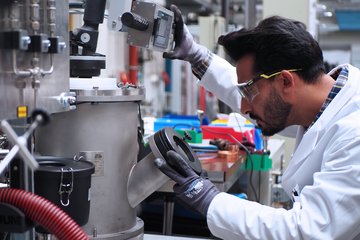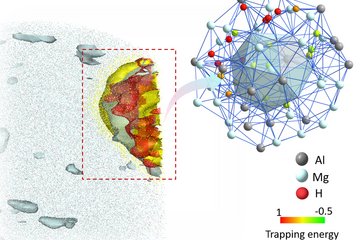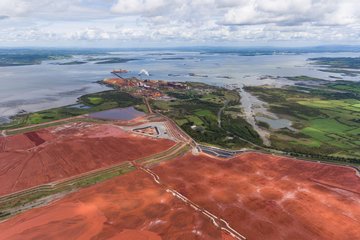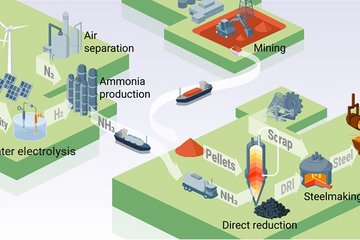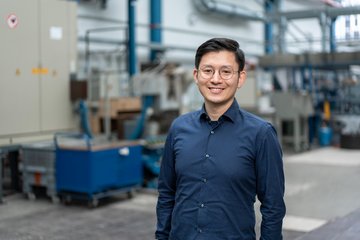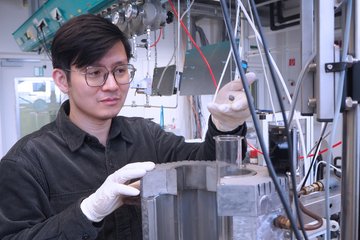Alle Typen
441.
Poster
3D Reconstruction of Identical Location Electron Micrographs – Methodology and Pitfalls. IAMNano 2019, International Workshop on Advanced and In-situ Microscopies of Functional Nanomaterials and Devices, Düsseldorf, Germany (2019)
442.
Poster
Local strain field in distorted 1T (1Td) MoS2 phases by GPA. International Workshop on Advanced and In-situ Microscopies of Functional Nanomaterials and Devices, IAMNano 2019, Düsseldorf, Germany (2019)
443.
Poster
Study of the phase transition in multi-principle element alloy nanoparticles by in-situ heating TEM. Microscopy Conference (MC 2019), Berlin, Germany (2019)
444.
Poster
Component-based quantification of EELS spectrum imaging: Philosophy and examples. Microscopy Conference 2019, Berlin, Germany (2019)
445.
Poster
Structural study and luminescence properties of Lanthanide-doped oxides. Microscopy Conference 2019, Berlin, Germany (2019)
446.
Poster
Nanohybrid materials and thin films for battery applications. Microscopy Conference, Berlin, Germany (2019)
447.
Poster
Insights in pore-interconnected hollow (Sn,Ti)O2 nanoparticle networks for lithium-ion battery anodes. Microscopy Conference MC2019 , Berlin, Germany (2019)
448.
Poster
Microscopic study of a low temperature synthesized MoAlB coating by combinatorial direct current magnetron sputtering. Microscopy Conference, MC 2019, Berlin, Germany (2019)
449.
Poster
Cathodoluminescence and the structural study of Lanthanide-doped oxides. Workshop on Transmission Electron Microscopy (E-MAT), Antwerp, Belgium (2019)
450.
Poster
Study of the chemical composition and the luminescent spectra of Lanthanide-doped oxides. E-MRS 2019 Spring Meeting, Nice, France (2019)
451.
Poster
Phase transitions in Cr2AlC thin films by in situ TEM heating experiment. Fifth Conference on Frontiers of Aberration Corrected Electron Microscopy, PICO 2019, Vaalsbroek, The Netherlands (2019)
452.
Poster
In-operando photocorrosion study on BiVO4 photoanodes. International Bunsen Discussion Meeting, Taormina, Italy (2019)
453.
Poster
NiOx cocatalysts on nanosheets for photocatalytic water splitting. nanoGe Fall Meeting 2018, Torremolinos, Spain (2018)
454.
Poster
Electron beam induced crystallization of co-sputtered amorphous high entropy alloy nanoparticles in ionic liquid. International Microscopy Congress, Sydney, Australia (2018)
455.
Poster
In-situ observation of irregular void growth in Al thin films during solid state dewetting. 19th International Microscopy Congress (IMC19), Sydney, Australia (2018)
456.
Poster
Tracking the Degradation of Fuel Cell Catalyst Particles: 3D Reconstruction of Nanoscale Transmission Electron Micrographs. CINEMAX IV, "Best poster Award at the Summer School", Toreby, Denmark (2018)
457.
Poster
Oxygen deficient TiO2 nanowire film as support in oxygen involving electrocatalysis. E-MRS Spring Meeting, Strasbourg, France (2018)
458.
Poster
Microstructure characterization on electrodes and catalysts. Chinese-German Chemical Association (CGCA) 30th Annual Conference, Berlin, Germany (2018)
459.
Poster
Supervision on multi-dimensional data from electron microscopy. BiGmaxWorkshop 2018 on Big-Data-DrivenMaterials Science, Irsee, Germany (2018)
460.
Poster
Texture evolution and solid state dewetting of passivated Al thin films on Al2O3. International GRK 1896 Satellite Symposium "In Situ Microscopy with Electrons, X-rays and Scanning Probes", Erlangen, Germany (2017)
